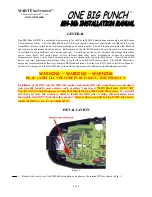
Electrical data, connections and wiring
MLZ single phase scroll compressors are
designed to operate without any assistance. If
starting within the defined voltage range, PSC
wiring is sufficient.
PSC wiring with a run capacitor only is the
default wiring solution for single phase MLZ
compressors.
The start winding (C-S) of the motor remains in
circuit through a permanent (run) capacitor. This
permanent (run) capacitor is connected between
the start winding (S) and the run winding (R).
Electrical connections
PSC wiring
Winding resistance
Winding resistance is the resistance between
indicated terminal pins at 25°C (77°F) (resistance
value +/- 7%).
Winding resistance is generally low and it
requires adapted tools for precise measurement.
Use a digital ohm-meter, a ‘4 wires’ method and
measure under stabilised ambient temperature.
Winding resistance varies strongly with winding
temperature ; If the compressor is stabilised at
a different value than 25°C (77°F), the measured
resistance must be corrected with following
formula:
a + t
amb
R
tamb
= R
25°C (77°F)
a + t
25°C (77°F)
t
25°C
: reference temperature = 25°C (77°F)
t
amb
: temperature during measurement (°C/°F)
R
25°C (77°F)
: winding resistance at 25°C (77°F)
R
amb
: winding resistance at t
amb
coefficient a= 234.5
N
L1
Run capacitor
Thermostat
C
S
R
IOL
PTCSCR wiring
If the starting torque of the PSC wiring is not
sufficient due to pressures not fully equalized
during the off-cycle or some voltage drop during
starting, the PTCSCR wiring might be an option.
PTCSRC wiring provides more motor torque than
PSC wiring but less than CSR wiring. The PTC is
wired in parallel to the run capacitor.
When starting the compressor, the PTC, which
is at low resistance, provides additional starting
current to the motor’s start winding. The current
passing through the PTC causes it to heat up
and, at a certain temperature, change to a very
high resistance. At this time the motor is up to
nominal speed and the run capacitor determines
the current through the start winding. The PTC
remains at high temperature and thus at high
resistance as long as power is connected to the
compressor. When the compressor is switched
off, the PTC cools down to its initial low resistance
and becomes available to support the next
compressor start.
LRA is the higher average current as measured
on a mechanically blocked compressor tested
under nominal voltage. LRA is printed on the
nameplate.
The LRA value can be used as a rough estimation
for the starting current. However in most cases,
the real starting current will be lower. Many
countries have defined limits for the starting
current in domestic use. A soft starter can be
applied to reduce starting current.
The MCC is the current at which the internal
motor protection trips under maximum load and
low voltage conditions.
This MCC value is the maximum at which
the compressor can be operated in transient
conditions and out of the application envelope.
Above this value the overload will switch off to
protect the motor.
MCC (Maximum
Continuous Current)
LRA (Locked Rotor Amp)
The Max Oper. A is the current when the
compressor operates at maximum load
conditions and 10% below nominal voltage.
This value which is the max rated load current for
the compressor is new on the nameplate.
Max Oper. A can be used to select cables and
contactors.
In normal operation, the compressor current
consumption is always less than the Max Oper. A
value. When using the Max Operating Current to
define cables and contactors, a tolerance of +5%
need to be taken into account.
Max Oper. A (Maximum
Operating Amp)
AB243286444663en-001003
17
Application Guidelines
Summary of Contents for MLZ Evolution A
Page 2: ......
















































